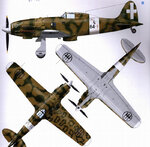Don't disagree. However, during WW2 it's usually the Brits who get painted as the rule-bound bureaucrats while the American free-spirit-thinkers just did what was needed to get the job done. Given the very rough field conditions at Guadalcanal, I have a really hard time believing that stuff-shirtedness would last very long.
Maintenance rules were being broken all the time on Guadalcanal as wrecks were cannibalized for spares. The prospect of greatly improving the performance of the key USAAF fighter in the region by "simply" removing some unnecessary armour plate and the "useless" wing guns strikes me as small beans compared to some of the hybrid airframes that are seen in photos. The book "Lightning Strikes" by Donald A. Davis describes one of the hybrid airframes at Cactus:
"Since there were so few P-400's in service, every cannibalized part could keep another plane flying. The favorite P-400 on the island was a battered craft that had skidded to a halt one day after landing on its belly because its wheels collapsed. It came to a rest with a wing crumpled and the propeller bent, making it an open source for spare parts. However, the need for flyable aircraft was so great that mechanics nursed it back to health. One wing was U.S. Army olive green and the other was British camouflage. Instruments were plugged into gapping holes in the cockpit panel. The three-bladed propeller contained two blades from one wrecked plane and one blade form another; it was balanced by pouring lead in until it spun almost correctly. The aircraft took on a strange personality all its own and would outlast every other plane in the squadron. It was proudly christened The Resurrection."
Given that mish-mash of parts and missing components, the prospect of taking out armour plate and a couple of wing guns really is trivial.
It wasn't done just in Guadalcanal...

